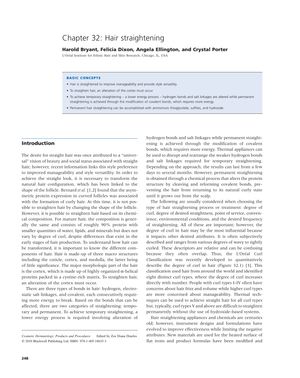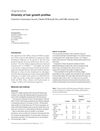Hair Straightening: Techniques, Chemicals, and Evolution
March 2010
in “
Cosmetic Dermatology
”

TLDR Hair straightening methods have advanced to improve effectiveness and reduce damage, but still rely on heat and chemicals.
Hair straightening aimed to improve manageability and style versatility by altering the hair's cortex. Temporary straightening involved low-energy processes affecting hydrogen bonds and salt linkages, while permanent straightening required high-energy processes to modify covalent bonds. Permanent methods used chemicals like ammonium thioglycolate, sulfites, and hydroxide. The L'Oréal Curl Classification identified eight curl types, influencing the choice of straightening method. Thermal appliances, such as flat irons, were popular for temporary straightening but could damage hair at high temperatures. Chemical straighteners, including thioglycolate and sulfites, varied in effectiveness and potential scalp irritation. Hydroxide-based systems were necessary for highly curled hair types. Advances in materials and formulations aimed to enhance effectiveness and minimize damage.
Hair straightening treatments have evolved significantly since the 1930s, starting with homemade chemical mixtures and advancing to commercial relaxers in the 1950s. Early relaxers used sodium hydroxide (lye) and required scalp protection due to their corrosive nature. By the 1960s, no-base relaxers were developed, reducing scalp irritation. The late 1970s saw the introduction of no-lye relaxers, which further minimized irritation. Relaxers work by chemically altering hair proteins, leading to permanent straightening but also causing potential damage such as cuticle erosion and weakened hair strength. Proper application and post-treatment care, including conditioning, are crucial to maintaining hair integrity. Despite advancements, the fundamental methods of using heat and chemicals remain, with ongoing improvements aimed at reducing adverse effects and enhancing hair quality.



